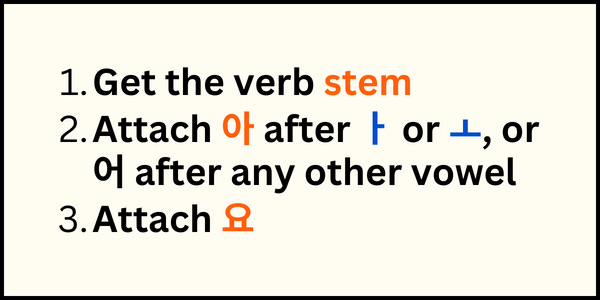안녕! Hi, there!👋🏻
I hope you are having a great week so far😇! I gave you a little homework to do and about 30 people have tried conjugating the verbs! Thank you very much for actively getting engaged in my newsletter lessons🙏🏻.
Instead of replying to each comment, I decided to share the answer via another post with some detailed explanation so that everyone including the ones who are just reading the lessons is on the same page😉!
So, here we have the five verbs in the infinitive form:
➊ 앉다: to sit ➝ ?
➋ 만들다: to make ➝ ?
➌ 보다: to see ➝ ?
➍ 주다: to give ➝ ?
➎ 다니다: to go somewhere for a purpose, to attend ➝ ?
The basic conjugation rule
We will apply this basic rule for each verb and see what happens.
Let’s take a look at them one by one.
➊ 앉다: to sit
Step 1: Get the verb stem ➝ 앉
Step 2: Attach 아 after ㅏ or ㅗ, or attach 어 after any other vowel ➝ 앉아
Step 3: Attach 요 ➝ 앉아요
Answer: 앉아요
This was easy because the stem has a final consonant. In other words, verbs that have a stem that ends with a consonant will follow the basic rule.
➋ 만들다: to make ➝ ?
Step 1: Get the verb stem ➝ 만들
Step 2: Attach 아 after ㅏ or ㅗ, or attach 어 after any other vowel ➝ 만들어
Step 3: Attach 요 ➝ 만들어요
Answer: 만들어요
This verb also has a consonant ending stem, so it worked just fine!
➌ 보다: to see ➝ ?
Step 1: Get the verb stem ➝ 보
Step 2: Attach 아 after ㅏ or ㅗ, or attach 어 after any other vowel ➝ 보아
Step 3: Attach 요 ➝ 보아요
Now, this verb has a vowel ending stem, not a consonant ending stem. Therefore, we need to combine the two vowels before 요 which are ㅗ and ㅏ. If you try and say these two vowels fast, it would sound like 와 [wa], so the outcome becomes 봐요.
Answer: 봐요
➍ 주다: to give ➝ ?
Step 1: Get the verb stem ➝ 주
Step 2: Attach 아 after ㅏ or ㅗ, or attach 어 after any other vowel ➝ 주어
Step 3: Attach 요 ➝ 주어요
Again, this verb has a vowel ending stem, so we will try and say ㅜ and ㅓ in one go which results in 워 [wo] sound. As a result, the conjugation of the verb becomes 줘요.
Answer: 줘요
➎ 다니다: to go somewhere for a purpose, to attend ➝ ?
Step 1: Get the verb stem ➝ 다니
Step 2: Attach 아 after ㅏ or ㅗ, or attach 어 after any other vowel ➝ 다니어
Step 3: Attach 요 ➝ 다니어요
This one is a little tricky! For the verbs ➌ and ➍, we tried saying the two vowels fast and they both happened to have a compound vowel to be used:
➌ 보아요: ㅗ and ㅏ ➝ 와 [wa]
➍ 주어요: ㅜ and ㅓ ➝ 워 [wo]
So, can we do the same and just find a compound vowel that looks like the two vowels combined together?
➎ 다니어요: ㅣ and ㅓ ➝ 애 [e] ➝ 다내요
Wrong😱!
What is really important here is that, instead of looking at the vowels visually, we need to focus on the sounds they make combined together. If you try and say ㅣ and ㅓ fast, but in order, it doesn’t make a sound of 애 [e], it rather sounds more like ㅕ [yeo] (Try and say it yourself and see if this makes sense!). Therefore, the conjugation of the verb 다니다 is 다녀요.
Answer: 다녀요
That’s it for today! I hope this cleared up any doubt you had about last week’s lesson🙏🏻.
Let me know what you didn’t get right and if you now understand why you didn’t get it right. I’m looking forward to hearing from you!
Have a good rest of your week and I’ll talk to you again on Sunday!
담에 또 봐!💙
If you need to learn Korean alphabet and how to read Korean, consider purchasing my e-book here: Korean e-book: Read and Write Hangul in a Day





Hello I'm having trouble reading four letter syllables. Like this one. 읽다. To read. Are there any tips you can give for reading these kinds of syllables?
감사합니다 I got the last one wrong. Great explanation. I need to do a better job of listening to how it would sound vs just mechanically following the rules. Have a good weekend, 선생님!